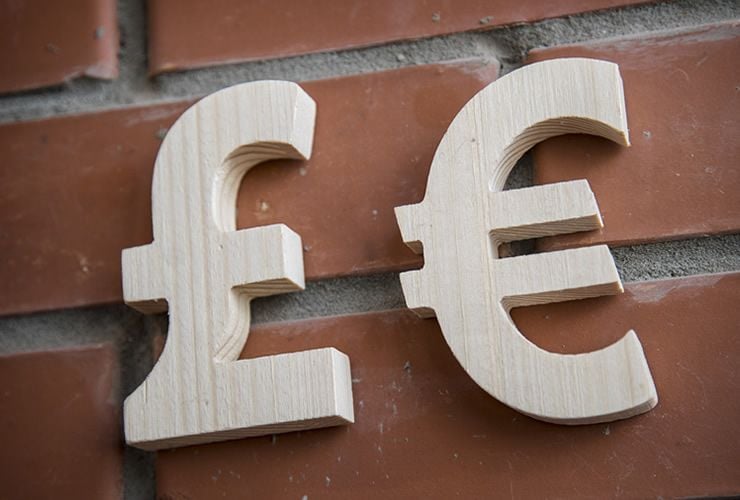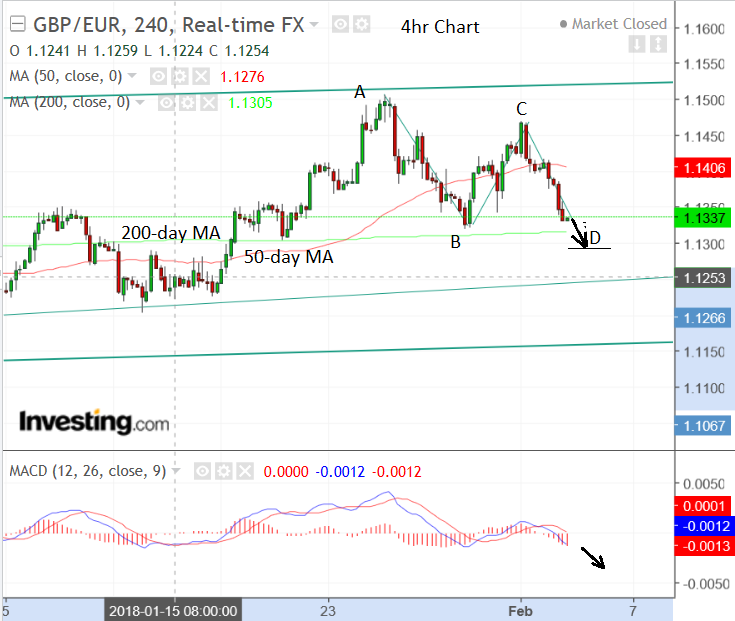5-Day Pound-to-Euro Exchange Rate Forecast

With the GBP/EUR exchange rate approaching equilibrium again this week's Bank of England meeting on Thursday stands out as a potential source of volatility.
The Pound-to-Euro exchange rate continues to trade within a range between 1.1150 and 1.1515 - as it has done for almost six months now.
We thought it might breakout when it rose up and made a new high of 1.1513, on January 25, however buying interest soon fizzled out at this resistance zone while a flood of sell orders were triggered as is often the case at key technical levels.
The pair is now back in the middle of the range after closing the last week at 1.1333, and we see a high probability of a continuation lower to 1.3300 in the immediate future.
"Little damage has thus far been done by a recent secondary rejection around 1.1500 but the relatively shallow angle of ascent from an intermediate standpoint is also limiting upside potential here at present," says analyst Lucy Lillicrap with AFEX, a foreign exchange brokerage based in London.
We note the move down from the January highs has formed the outline of what looks like an incomplete ABCD pattern which we expect to finish with an extension of wave C-D to 1.1300 which is where it will reach wave length equality with A-B, as the pattern predicts.
Beyond that, the direction is difficult to determine but overall we stand by our previous forecast of an eventual breakout higher, although we would now wish to see confirmation from a move above 1.1570, given the resistance now at 1.1550 from the R1 monthly pivot.
Pivots are often levels where the market stalls, turns or even reverses.
They are calculated from data for the previous period and traders often use them as reference points to place orders against the direction of the main trend.
A break above 1.1570, however, would see a probable continuation higher to a target at 1.1690.
Taking a look at the longer-term, the weekly chart below shows the pair has broken cleanly above a major long-term trendline drawn from the 2014 highs and this is a broadly bullish signal. We also feel that purely from a look-and-feel perspective the weekly chart favours a break higher over a move back down to the 1.08-09 lows again.
A fly in the ointment of the bullish forecast, however, is the not-so bullish looking momentum indicator - the MACD (circled) - in the lower panel. The MACD has moved higher and touched the zero-line but is now taper to a point with its signal line and looks vulnerable to weakness, which would be bearish for the pair.
Nevertheless, for now, we remain bullish expecting a breakout higher as previously forecast.
Get up to 5% more foreign exchange by using a specialist provider to get closer to the real market rate and avoid the gaping spreads charged by your bank when providing currency. Learn more here.
Data and Events to Watch for the Pound
The main event in the week ahead for the Pound is the Bank of England (BOE) rate meeting on Thursday, Feb 8 at 12.00 GMT.
Analysts do not expect a change in interest rates so the focus instead will be on attempting to guess when the next change will come by analysing voting patterns, the wording of the statement and governor Carney's verbal responses to questions in the press conference after.
If the evidence points to a rate rise getting more likely then the Pound will rise; if not then it will fall.
Brexit risks continue to cause uncertainty about the outlook and weigh on the BOE's reaction function, and given those risks have not changed substantially, little change is expected, and possibly a muted response from Sterling.
The other main event is the release of the BOE's Quarterly Inflation Report at the same times as the meeting, and given inflation is one of the main factors which lead to higher interest rates, and interest rates are positively correlated to the Pound this too could impact on Sterling.
If economic growth and inflation forecasts are revised higher expect Sterling to catch a bid.
"We have long-argued that interest rates would rise somewhat faster, and sooner than markets expecting. Recent comments by Governor Carney offer tentative support to this view and suggest that February’s Inflation Report could strike a more hawkish tone than is anticipated," says Paul Hollingsworth economist at Capital Economics.
Inflation is currently 3.0% and has been caused mainly by the depreciation of Sterling since the EU vote in June 2016. The BoE has said it is willing to allow inflaton to overshoot for a limited period before tackling it, however, Hollingsworth thinks they may start to show an impatience, given the stronger-than-expected performance of the economy. Such a change would be expected to lead to a modest rise in Sterling.
Other significant data in the coming week includes the services sector PMI out on Monday at 9.30 and Halifax house price data for January out at 8.30 on Tuesday. Industrial, manufacturing and trade data round off the week.
Markets are expecting a reading of 54.3 from Monday's service sector PMI - anything better will likely set Sterling on a strong footing at the start of the new week, while disappointment could add to the bearish tone.
"While most of the early data was suggesting we could see the services sector run flat, the weak prints on both the manufacturing and construction PMIs last week now points to the Services PMI declining from 54.2 to 53.2, versus a consensus of 54.0, though we suspect that may likely drift lower by the time of release. The January PMIs so far suggest the adjustment in the housing sector persisted into January while more of the demand was coming from external sources rather than domestic, all suggesting no reason the Services PMI should outperform the softer January data," says a note on the matter from TD Securities.
The Halifax data may garner interest because last week's Nationwide data showed an unexpected surge in house prices in January, which lifted Sterling, and the market will be looking to the Halifax data to corroborate it.
Friday, meanwhile, sees the release of manufacturing and industrial production and the trade balance for December, all out at 9.30.
Markets are eyeing monthly industrial production to have slid 0.9% in December with the manufacturing production number showing an increase of 1.2%.
Trade data should show a balance of -£11.60BN as the UK continues to import more than it exports.
With regards to the above, the manufacturing data is expected to have the most impact on Sterling.
Data and Events for the Euro
What data there is, starts with retail sales on Monday at 10.00 GMT with analysts forecasting a 1.9% rise in December from a year ago, and a -1.0% decline compared with the previous month.
There's very little Eurozone data in the coming week to threaten the currency's positive outlook and for that reason we expect Euro to continue to outperform other major currencies (barring any surprises from central banks)," says BK Asset Managment Managing Director Kathy Lien.
Monday also sees a speech from European Central Bank (ECB) president Mario Draghi at 16.00, although his message is unlikely to have changed materially from that at the recent ECB rate meeting press conference.
Finally, on Thursday at 9.00, the ECB releases its Economic Bulletin, which will probably officially back up the current positive outlook for the region.
Fears that the Euro was getting overpriced - which poses as a headwind to the Eurozone's economic expansion - appear to have been misplaced removing another obstacle to further Euro appreciation.
"The economy is recovering and the effect of a strong Euro on inflation has been limited. As a result, Eurozone policymakers have become more tolerant of the rising currency and more eager to end asset purchases," says Lien.
Get up to 5% more foreign exchange by using a specialist provider to get closer to the real market rate and avoid the gaping spreads charged by your bank when providing currency. Learn more here.







